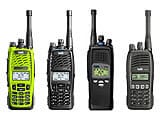This is the first in a series of articles we’ll present on migrating from legacy radio networks to more modern technology, the advantages they can offer your organization and how Tait solutions can make it a simple process.
Migrating from Analog to P25
 If your department is using an analog or Analog Simulcast over IP radio network, you’ll already be familiar with the benefits those systems offer. One of the greatest strengths about Tait analog systems is how easy we make migration to a more feature rich P25 network, as the needs of your agency dictate.
If your department is using an analog or Analog Simulcast over IP radio network, you’ll already be familiar with the benefits those systems offer. One of the greatest strengths about Tait analog systems is how easy we make migration to a more feature rich P25 network, as the needs of your agency dictate.
Why upgrade to P25?
There are several benefits to upgrading to P25, including:
- Interoperability between agencies
- Greater choice of devices
- Increased security through encryption
- Next generation digital features
P25 is an open standard for public safety digital radio. Its real beauty is interoperability, allowing different departments to coordinate in emergency situations.
P25 devices from different vendors are compatible, and there is a wide range to choose from. This offers peace of mind to agencies that need specific features within budget restrictions.
To facilitate the need for security in public safety, P25 includes a robust encryption standard. In a sensitive law enforcement situation, users can communicate with the confidence that their calls are only being received by the intended recipients.
P25 takes advantage of modern features that add convenience and life saving capability to your network. GPS location services, Man Down and Lone Worker functionality protect the safety of your staff in the field.
You can learn more about the benefits of P25 at the Tait Radio Academy.
The case for migrating to P25 is clear, but how easy is the transition process?
A simple path
Tait offers a solution that makes migrating from analog to P25 a breeze.
Depending on the technology you currently have in place, it’s possible you already have elements of the infrastructure necessary to migrate to P25. The Tait solution is very flexible, offering several different migration paths. The graphic below illustrates one of those paths, and shows how the same hardware can be utilized in the various stages of migrating from an analog radio system through to P25 Phase 2.

Because P25 uses the same 12.5kHz frequencies as your existing narrow band FM or AS-IP network, your agency can continue to use its existing radio channels, simply upgrading key components as you decide the time is right for migration.
Analog to AS-IP
If you want to keep your analog network today, but prepare for P25 in the future, then the first step in migrating is a transition to Analog Simulcast over IP (AS-IP). This technology continues to use your existing radio frequency, but begins to incorporate digital features and builds a foundation of hardware that will be crucial in the potential shift to P25.
 The new hardware you’ll introduce during this stage is an AS-IP & P25 capable base station, the Tait TB9400 and TB7300. Any analog radio can work on the AS-IP network, but if you need to start updating terminals, then choose the multi-mode Tait TP9800, TP9600 and TP9400. These additions can be gradually implemented in phases, because each Tait 9400 base station and terminal is capable of Analog Conventional, Analog Simulcast, P25 Phase 1, and P25 Phase 2.
The new hardware you’ll introduce during this stage is an AS-IP & P25 capable base station, the Tait TB9400 and TB7300. Any analog radio can work on the AS-IP network, but if you need to start updating terminals, then choose the multi-mode Tait TP9800, TP9600 and TP9400. These additions can be gradually implemented in phases, because each Tait 9400 base station and terminal is capable of Analog Conventional, Analog Simulcast, P25 Phase 1, and P25 Phase 2.
The process need not be disruptive or costly. Your existing analog radios will continue to operate on this network, and you’ll be prepared to migrate to P25 whenever you see fit.
AS-IP to P25
When interoperability and the other benefits of P25 radio networks becomes a priority, its time to consider migrating from AS-IP to P25. Fortunately, if you installed the TB9400, you already have all the required network hardware in place. Since the Tait 9400 base stations and radios are P25 capable, the only real change is updating the software and feature licenses. It’s as simple as that.
Many agencies choose to keep their equipment in analog mode until all the hardware has been replaced with P25 capable equipment. Once that is complete, it’s time to “flip the switch” to P25.
P25 Phase 1 to Phase 2
 With twice the spectral efficiency of your existing network, P25 Phase 2 represents the premier standard of public safety radio networks. P25 Phase 2 is backwards compatible with P25 Phase 1, to once again ease the transition of migration, giving you tremendous value from your existing hardware.
With twice the spectral efficiency of your existing network, P25 Phase 2 represents the premier standard of public safety radio networks. P25 Phase 2 is backwards compatible with P25 Phase 1, to once again ease the transition of migration, giving you tremendous value from your existing hardware.
Start your Migration today
The migration path from analog to P25 radio networks is simple and efficient, providing your agency great tools to help get their jobs done. Every agency has unique needs, and our goal at Tait is to listen to your situation and propose the easiest migration path for you. For instance, you may not want AS-IP, or you might want to migrate straight to P25 Phase 2. The flexibility of the 9400 series makes all this possible and more.
If you’re interested in learning more about migrating your analog radio network to a modern digital network, get in touch with Tait Communications to discuss a long term solution that meets your organization’s needs.



